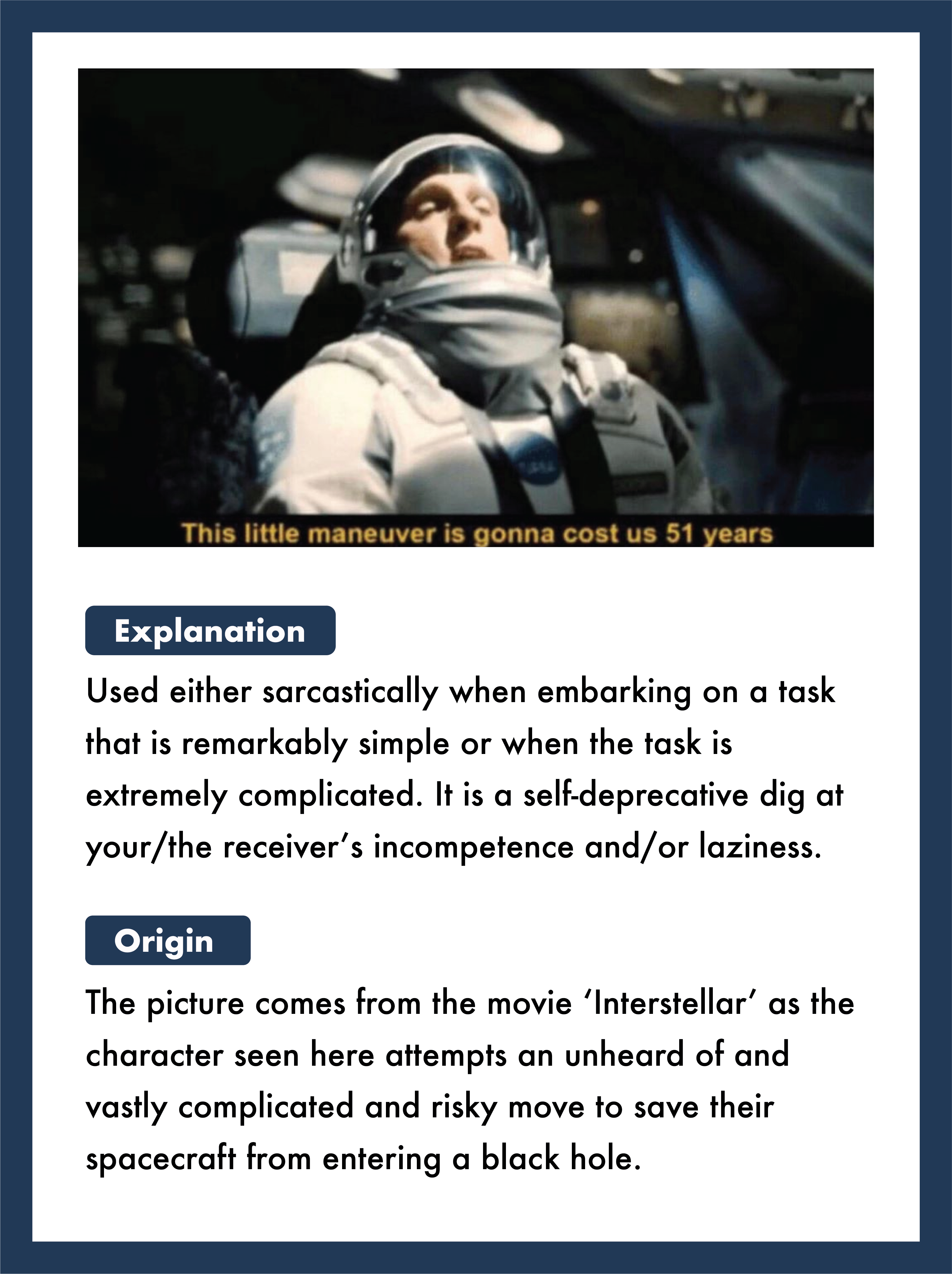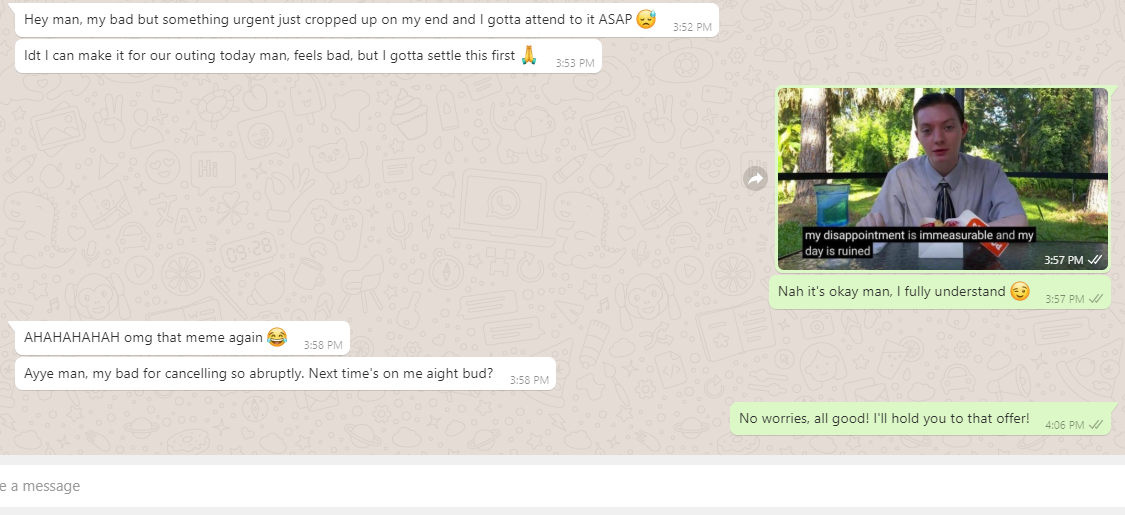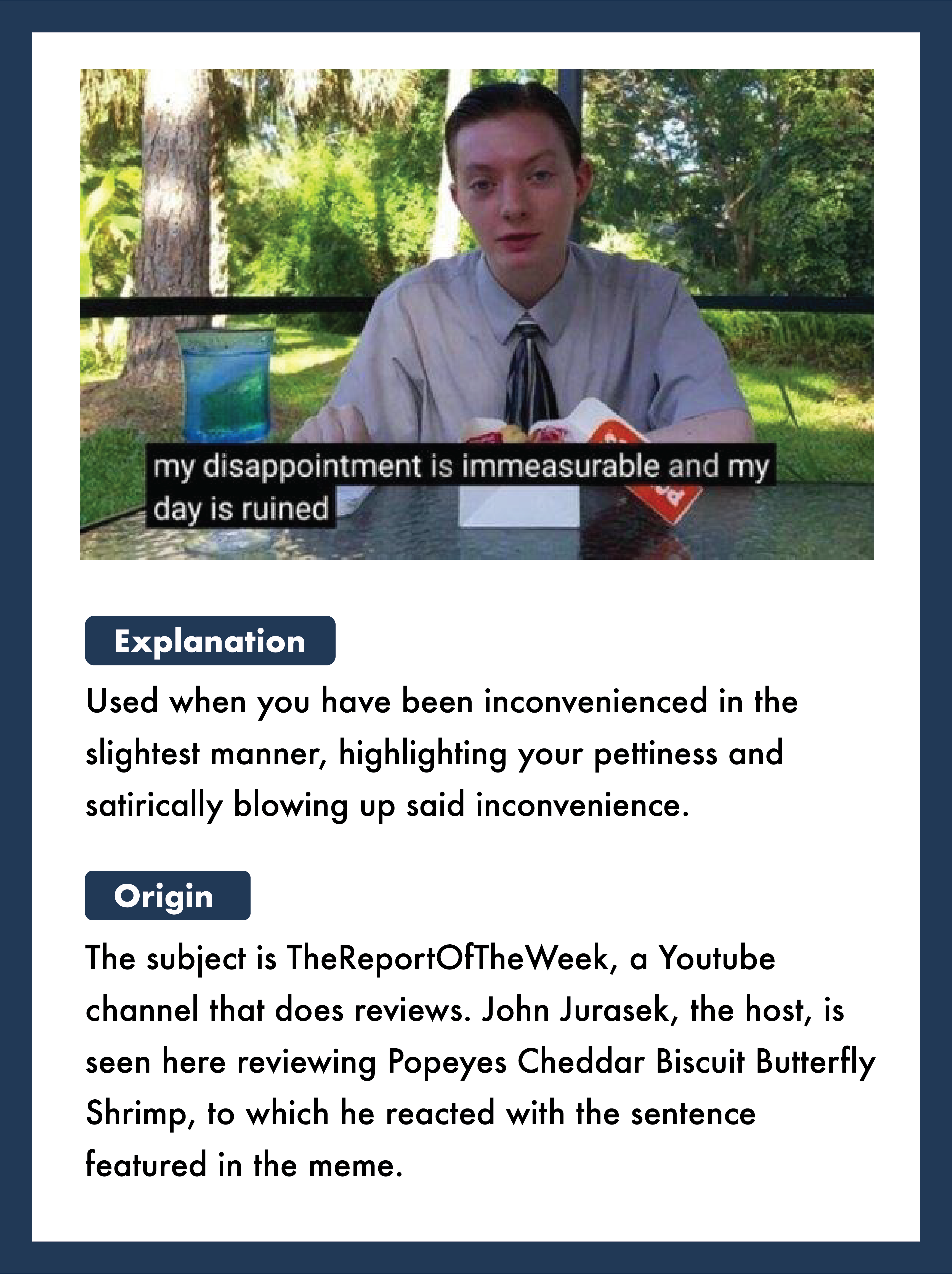Memes: Helping Our Complex Generation Communicate
Memes: we see them everywhere; on social media, text messages, the lot. We laugh at them but why do we? Shafiq Guee takes the plunge and delves deeper into the intricacies of meme culture.
BY
SHAFIQ GUEE
Published on
July 7, 2020

You spend all week thinking about that one outing with your friend. Lo and behold, a text comes in and he cancels on you, says something urgent cropped up and he has to attend to it.
You want to convey your disappointment, but not too much, else he gets offended. You want to respond in high spirits so as to not make him feel guilty, but also not sound too happy lest he thinks you were looking forward to the outing being cancelled.
A spot of humour would ease away the awkward tensions; a sprinkle of informality would do well to honour the long-time friendship you two share. Preferably not something too long on words that would blow up the situation. Too short, and even the greatest poets would struggle to squeeze all into a haiku verse.

“So, cognitive side of the brain, the stage has been set and the curtains have been drawn. He’s waiting for a response, what say you?” Photo courtesy of Shafiq Luqman Guee.
And just like that, as a sketchy minefield of emotions and ‘what-ifs’ have been dodged, therein lies the magic of memes; its ability to convey a bag of mixed emotions in a vehicle of relatability, aided by its playful, satirical nature.
But is there method to its madness? Seems so, take away the picture and the text seems heavily provocative and passive-aggressive. Take away the text and you have got a man in a suit and tie eating some fried chicken in his backyard. So, what makes a meme a meme, and why is it so good at generating grins?
So, what are memes?
Dictionary.com defines memes as: “A cultural item in the form of an image, video, phrase, etc., that is spread via the Internet and often altered in a creative or humorous way.”
In layman terms, it’s a crudely put together picture with text that aptly illustrates a situation or scenario. Often, these scenarios are very specific in nature; their intensity scaled up excessively in a bid to exaggerate the scenario in the name of satire.
Although the scenarios are specific, they’re widely-known enough to be considered commonplace in the daily lives of people. Sometimes it’s a screenshot from a popular movie, other times it’s just a simple photo. The accompanying text is often a quote derived from the picture or a crude description of it.
In short, memes emulate generic and common scenarios of daily life to an extremity, and those that reach your chat groups and social media do it dangerously well.
“For a meme to spread, it has to be in a form that people already want to spread,” said Jackie Tan, who is in his late-20s and is the co-owner of Telegram chat group Memes n Dreams, one of many meme-sharing groups on social media.
He added: “In most cases, it’s self-selection since memes that are not shareable and relatable would have died somewhere. So, the ones that you see are the ones that people want to share with their friends.”
In most cases, it’s self-selection since memes that are not shareable and relatable would have died somewhere. So, the ones that you see are the ones that people want to share with their friends.
Some even localise the memes themselves by adding supporting text or images relevant to their community.
While many send memes light-heartedly, a study conducted by YPULSE, a research group focused on understanding behaviours of Generation Z and Millennials, found that 53 per cent of teenagers send memes to convey emotions.
About 35 per cent send a meme as a code to someone who will understand them, and 28 per cent when they are unable to describe their emotions.
“A picture tells a thousand words [and] memes fit in that concept,” said Rasimah Jar via text, a relationship coach in her mid-50s.
The former lecturer at the Psychology Department of SMA-Edith Cowan University (Singapore Campus) added: “Teens use humour through memes as a preferred coping strategy.”
Teens use humour through memes as a preferred coping strategy.
She points out that boys in particular are subject to societal pressure to appear “strong, stoic, and unconcerned”, which is why they turn to memes as a better way of showing emotions.
Regarding this generation of teens, she believes the complex world today drives their behavioural pattern.
She added: “More analytical and critical thinking is expected of them to deal with almost everything in today’s context. It is natural for them to be unable to think ‘simple’ anymore when they are constantly bombarded with complex situations and thoughts.”
Julian Lo, 18, a member of Memes n Dreams and one of the top contributors to the group chat, thinks that memes are an effective way to express emotions. He said: “It helps because it’s a common language for people to express themselves.”
As to whether they are more effective than words, he said: “Sometimes, yeah. It’s easier to send stuff that the [other party] already knows the context to instead of forming a sentence to say how you feel.”
It’s easier to send stuff that the [other party] already knows the context to instead of forming sentence to say how you feel.
Jackie thinks it is the sense of community that brings a consoling feel, that “one would know that he/she isn’t alone in dealing with their issues.”
At the end of the day, what cannot be denied is that memes seek to spread joy, through grins or providing solace amongst the like-minded people who share them. The next time someone sends you a meme, do not just drop a “LOL”. Talk about it, there is a 50-50 chance a laugh was not the only thing they wanted to get off their chest.



the way you started this article is very enticing and relatable
After reading your article, it reminded me of some things about gate io that I studied before. The content is similar to yours, but your thinking is very special, which gave me a different idea. Thank you. But I still have some questions I want to ask you, I will always pay attention. Thanks.
… [Trackback]
[…] Find More on to that Topic: hypesingapore.com/index.php/2020/07/07/memes-helping-our-complex-generation-communicate/ […]
… [Trackback]
[…] Find More on to that Topic: hypesingapore.com/index.php/2020/07/07/memes-helping-our-complex-generation-communicate/ […]
… [Trackback]
[…] Find More Info here to that Topic: hypesingapore.com/index.php/2020/07/07/memes-helping-our-complex-generation-communicate/ […]
… [Trackback]
[…] Info to that Topic: hypesingapore.com/index.php/2020/07/07/memes-helping-our-complex-generation-communicate/ […]
… [Trackback]
[…] There you can find 97663 more Info to that Topic: hypesingapore.com/index.php/2020/07/07/memes-helping-our-complex-generation-communicate/ […]
… [Trackback]
[…] Find More to that Topic: hypesingapore.com/index.php/2020/07/07/memes-helping-our-complex-generation-communicate/ […]
… [Trackback]
[…] Find More on that Topic: hypesingapore.com/index.php/2020/07/07/memes-helping-our-complex-generation-communicate/ […]
… [Trackback]
[…] Find More to that Topic: hypesingapore.com/index.php/2020/07/07/memes-helping-our-complex-generation-communicate/ […]
… [Trackback]
[…] Information on that Topic: hypesingapore.com/index.php/2020/07/07/memes-helping-our-complex-generation-communicate/ […]
… [Trackback]
[…] Information on that Topic: hypesingapore.com/index.php/2020/07/07/memes-helping-our-complex-generation-communicate/ […]
… [Trackback]
[…] Find More on to that Topic: hypesingapore.com/index.php/2020/07/07/memes-helping-our-complex-generation-communicate/ […]
This was the fourth article that I have just been related to this topic and it was the one that made it most clear to me. I liked it. veja aqui
… [Trackback]
[…] Read More on that Topic: hypesingapore.com/index.php/2020/07/07/memes-helping-our-complex-generation-communicate/ […]
… [Trackback]
[…] Find More Info here on that Topic: hypesingapore.com/index.php/2020/07/07/memes-helping-our-complex-generation-communicate/ […]
… [Trackback]
[…] There you can find 61944 more Info to that Topic: hypesingapore.com/index.php/2020/07/07/memes-helping-our-complex-generation-communicate/ […]
… [Trackback]
[…] Find More here to that Topic: hypesingapore.com/index.php/2020/07/07/memes-helping-our-complex-generation-communicate/ […]
Thank you for your sharing. I am worried that I lack creative ideas. It is your article that makes me full of hope. Thank you. But, I have a question, can you help me?
… [Trackback]
[…] Read More on that Topic: hypesingapore.com/index.php/2020/07/07/memes-helping-our-complex-generation-communicate/ […]
… [Trackback]
[…] Read More on to that Topic: hypesingapore.com/index.php/2020/07/07/memes-helping-our-complex-generation-communicate/ […]
… [Trackback]
[…] Find More Information here on that Topic: hypesingapore.com/index.php/2020/07/07/memes-helping-our-complex-generation-communicate/ […]
… [Trackback]
[…] There you can find 39521 more Information on that Topic: hypesingapore.com/index.php/2020/07/07/memes-helping-our-complex-generation-communicate/ […]
… [Trackback]
[…] Read More on to that Topic: hypesingapore.com/index.php/2020/07/07/memes-helping-our-complex-generation-communicate/ […]
… [Trackback]
[…] There you can find 25468 additional Information on that Topic: hypesingapore.com/index.php/2020/07/07/memes-helping-our-complex-generation-communicate/ […]
… [Trackback]
[…] Read More on that Topic: hypesingapore.com/index.php/2020/07/07/memes-helping-our-complex-generation-communicate/ […]
… [Trackback]
[…] Read More on that Topic: hypesingapore.com/index.php/2020/07/07/memes-helping-our-complex-generation-communicate/ […]
… [Trackback]
[…] Information on that Topic: hypesingapore.com/index.php/2020/07/07/memes-helping-our-complex-generation-communicate/ […]
… [Trackback]
[…] Read More on that Topic: hypesingapore.com/index.php/2020/07/07/memes-helping-our-complex-generation-communicate/ […]
… [Trackback]
[…] Here you will find 40343 additional Info to that Topic: hypesingapore.com/index.php/2020/07/07/memes-helping-our-complex-generation-communicate/ […]
… [Trackback]
[…] Find More to that Topic: hypesingapore.com/index.php/2020/07/07/memes-helping-our-complex-generation-communicate/ […]
Thanks for sharing. I read many of your blog posts, cool, your blog is very good.
… [Trackback]
[…] Read More on that Topic: hypesingapore.com/index.php/2020/07/07/memes-helping-our-complex-generation-communicate/ […]
… [Trackback]
[…] Read More here on that Topic: hypesingapore.com/index.php/2020/07/07/memes-helping-our-complex-generation-communicate/ […]
Your point of view caught my eye and was very interesting. Thanks. I have a question for you.
… [Trackback]
[…] Info on that Topic: hypesingapore.com/index.php/2020/07/07/memes-helping-our-complex-generation-communicate/ […]
… [Trackback]
[…] Find More to that Topic: hypesingapore.com/index.php/2020/07/07/memes-helping-our-complex-generation-communicate/ […]
… [Trackback]
[…] There you will find 96106 more Info on that Topic: hypesingapore.com/index.php/2020/07/07/memes-helping-our-complex-generation-communicate/ […]
… [Trackback]
[…] Find More Info here to that Topic: hypesingapore.com/index.php/2020/07/07/memes-helping-our-complex-generation-communicate/ […]
… [Trackback]
[…] Find More on on that Topic: hypesingapore.com/index.php/2020/07/07/memes-helping-our-complex-generation-communicate/ […]
… [Trackback]
[…] Read More to that Topic: hypesingapore.com/index.php/2020/07/07/memes-helping-our-complex-generation-communicate/ […]
… [Trackback]
[…] There you will find 75900 more Information to that Topic: hypesingapore.com/index.php/2020/07/07/memes-helping-our-complex-generation-communicate/ […]
… [Trackback]
[…] Find More Info here on that Topic: hypesingapore.com/index.php/2020/07/07/memes-helping-our-complex-generation-communicate/ […]
I don’t think the title of your article matches the content lol. Just kidding, mainly because I had some doubts after reading the article.
… [Trackback]
[…] Find More Info here on that Topic: hypesingapore.com/index.php/2020/07/07/memes-helping-our-complex-generation-communicate/ […]
… [Trackback]
[…] Information on that Topic: hypesingapore.com/index.php/2020/07/07/memes-helping-our-complex-generation-communicate/ […]
… [Trackback]
[…] Find More on on that Topic: hypesingapore.com/index.php/2020/07/07/memes-helping-our-complex-generation-communicate/ […]
… [Trackback]
[…] There you will find 90937 additional Info to that Topic: hypesingapore.com/index.php/2020/07/07/memes-helping-our-complex-generation-communicate/ […]
… [Trackback]
[…] Find More on on that Topic: hypesingapore.com/index.php/2020/07/07/memes-helping-our-complex-generation-communicate/ […]
… [Trackback]
[…] Find More to that Topic: hypesingapore.com/index.php/2020/07/07/memes-helping-our-complex-generation-communicate/ […]